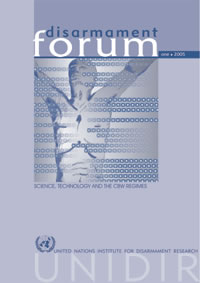The revolution in the life sciences is driving new discoveries and applications in medicine, psychology and health. Our developing understanding of how the body and its components work at the most basic levels allows us to envision treatments and cures hitherto unimaginable. However, the possibilities for malign use of these breakthroughs are both terrifying and vast. The ability to influence life processes at the molecular level means the ability to turn the body into a weapon against itself. This is particularly disturbing as international discussion and the relevant legal prohibitions appear to lag far behind the pace of scientific progress.
This issue of Disarmament Forum focuses on advances in science and technology and their implications for the chemical and biological weapons regimes. After an overview of scientific and technological developments and their relation to the regimes, authors explore a few worrying applications made possible by developments in neuroscience and immunology, current research on “non-lethal” weapons, and the possible utility of a code of conduct for those working in the life sciences.
Citation: Kerstin Vignard (ed.) (2005). "Disarmament Forum: Science, Technology and the CBW Regimes", UNIDIR, Geneva.
Disponible aussi en français.
Content
- Editor’s note, Kerstin Vignard
- Special Comment, Robin M. Coupland
- Science, technology and the CBW control regimes, Alexander Kelle
- The malign misuse of neuroscience, Malcolm Dando
- Assault on the immune system, Kathryn Nixdorff
- Non-lethal technologies—an overview, Nick Lewer & Neil Davison
- Biological weapons and the life sciences: the potential for professional codes, Brian Rappert
- Lessons from the implementation of the anti-personnel Mine Ban Convention, Ambassador Stephan Nellen
- UNIDIR Focus
